Even before man had discovered fire, he utilized tools in his everyday life. Most certainly in his array of tools were weapons that he used to kill game for food and to defend himself from other tribes intent on taking what was his.
The first weapons were of very simple design, made from stone or wood. Very likely man first realized the value of weapons when he threw a rock at a bird or rabbit to provide food for himself and his tribe or family.
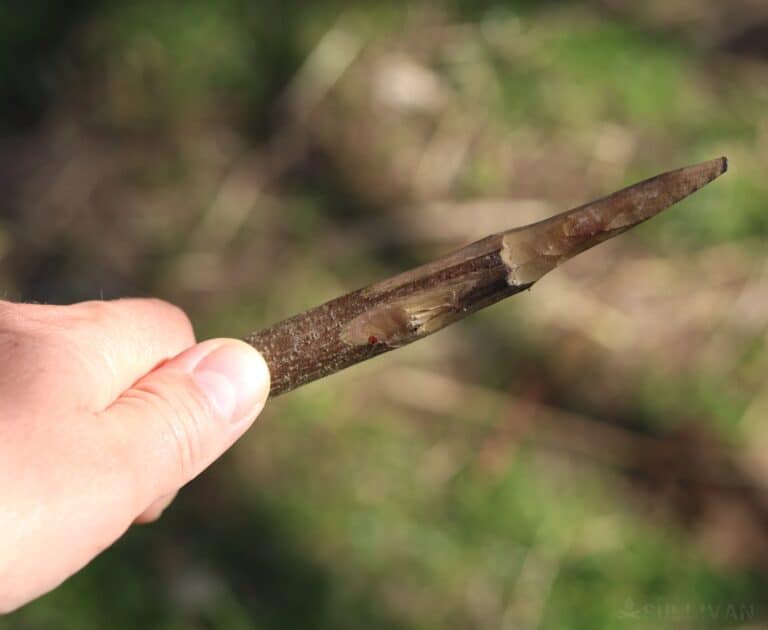
As man realized the usefulness and importance of weapons he tried to create more effective weapons. So through trial and error over the centuries stone was eventually replaced with steel.
Some of the most widely used primitive hunting weapons include bows and arrows, spears, crossbows, throwing stones, muzzleloaders, bolas, and blowguns.
We’re going to look at these and many more in what follows…
Table of Contents
Beware of State and Local Regulations
Before we get started, it is important to point out that you should make yourself aware of all relevant state and local laws and regulations concerning weapons where you live.
Even in the case of ancient designs like these, even if they are made from primitive, natural, scavenged materials, there is still a possibility they could be illegal under the law to possess or to use.
Now, obviously in the middle of a genuine survival scenario or any situation where there is no rule of law you must do what you have to in order to keep yourself safe. I only bring this up so you don’t accidentally incriminate yourself engaging in practice of crafting survival weapons as an academic exercise. Know the law, and then proceed!
Throwing Stones, the Most Basic Primitive Weapons
By simply throwing a stone man could extend his reach far beyond his grasp. Small animals like birds, rabbits, squirrels, or even lizards and snakes can be taken with a rock. However, sometime in the distant past man determined that he could throw a stone much farther and harder by using a sling.
The oldest known surviving example of a sling is from about 2,500 years ago in South America, although it’s almost certain it has existed much longer.
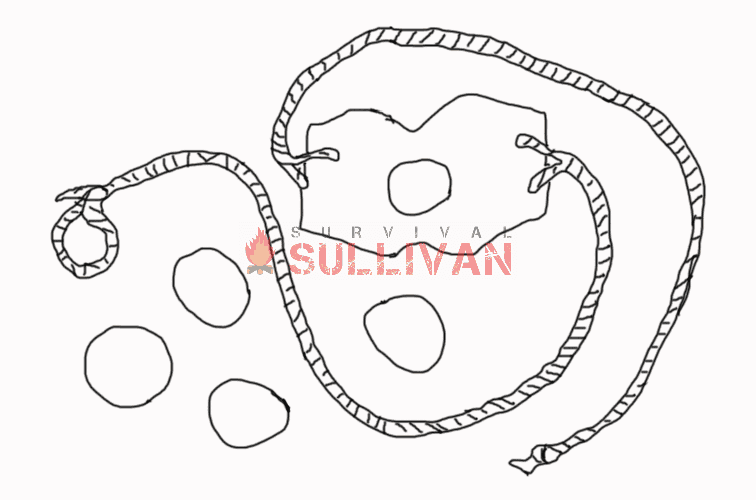
A sling is a length of cord made from plant fibers like hemp or flax, or materials from animals like wool or leather. It consisted of a finger loop on one end to insert the thumb or middle finger with a small flat pouch in the middle, it then had a small grip on the end made from a knot or a flat patch.
By placing the stone in the center patch, grasping the free end, spinning the sling over the head then releasing the free end at just the right time, (this takes quite a bit of practice) a stone can be hurled much farther and harder than throwing by hand. Larger game could be taken with a sling by hitting it in the head with the projectile.
A man could be easily brought down using a sling as well. As technology advanced, lead sling bullets that could travel twice the distance of stone and hit the target with much greater effect replaced the stone projectiles. Slings were actually used quite frequently and with great effect as a weapon of war in ancient times.
Here is an excellent video showing how to make and use a sling from plant fiber:
A modern-day version of the sling is the slingshot. This consists of a “Y” shaped device with rubber bands or tubes attached to the ends of the verticals with a pouch in the center.
By placing a rock or lead or steel projectile in the pouch, pinching the pouch closed around the projectile, drawing it back, and releasing it, the projectile flies through the verticals onto the target.
This can be made using wood or steel to create the handle, a cloth, canvas, or leather patch for the pouch, and any type of sturdy elastic bands. Modern-day slingshots are designed so that the handle extends and wraps around the forearm in order to brace it for greater control and accuracy.
The Humble Stick
Another of the earliest weapons was simply a long, pointed stick. A spear made from sharpening the end of a long straight pole into a tapering point and then hardening the point with fire probably came into use about the same time man was simply throwing rocks by hand.
This hardening was achieved by repeatedly heating the tip by plunging it into the coals of fire and then rubbing it with stone. This process done correctly could create a tip harder than copper:
A spear could be carried, used as a walking stick, used and reused, and was much more effective in close quarters than a rock as well as more effective in bringing down larger game. Used as a defensive weapon against attacks by dangerous animals or rival tribes, a spear would kill by poking a hole and letting blood.
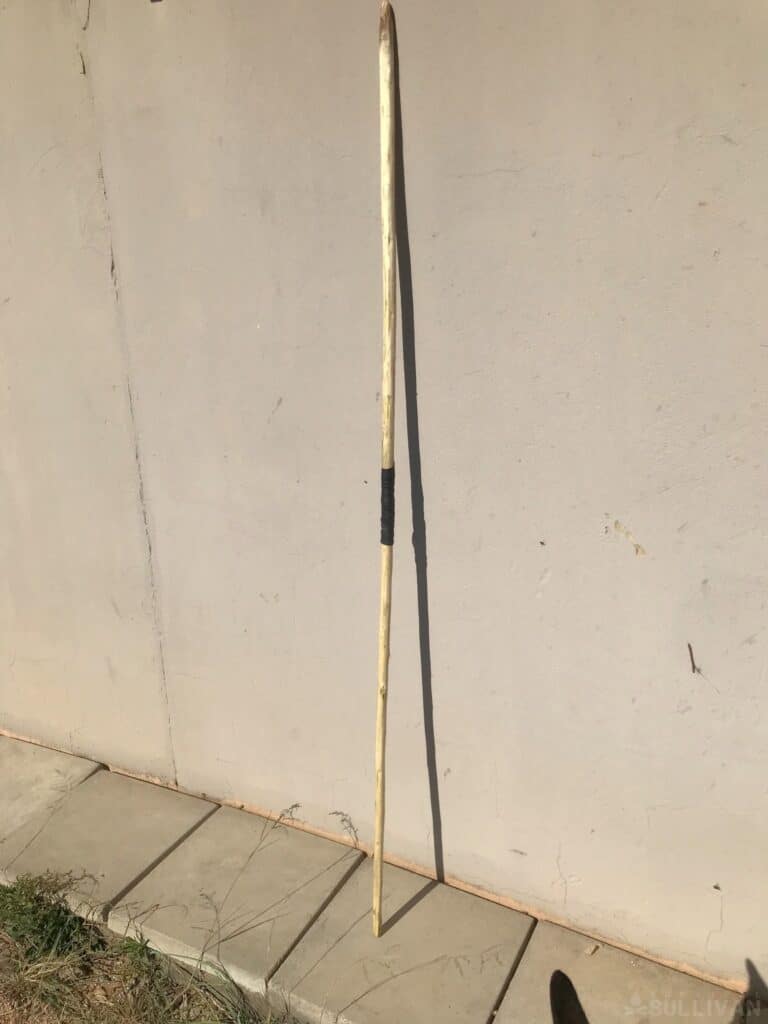
It wasn’t much of a stretch from thrusting with the spear to throwing it.
When hunting with a spear the spear would be thrown into the animal in the area of the lungs and heart, when the animal ran the spear would twist around inside doing further damage until it became dislodged.
The hunter would then track the animal by the blood trails until he came to the dead animal. Often the hunter would carry several spears in case of misses and to remain armed after throwing.
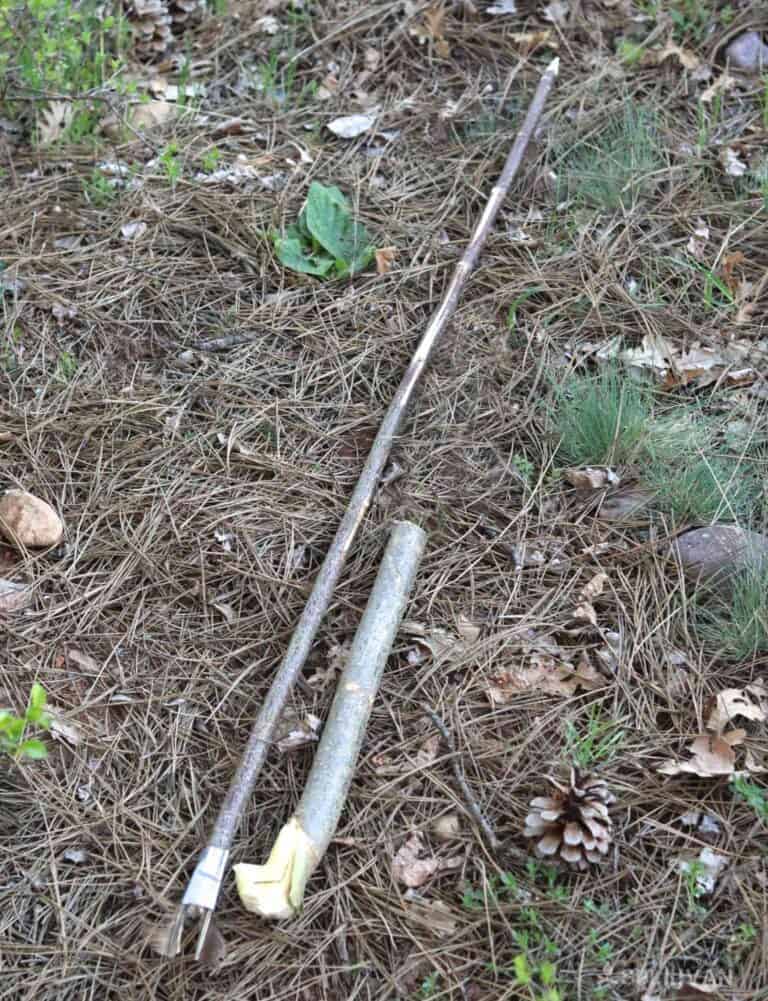
Atl-Atls
Further development of the spear included a lever consisting of a stick about half the length of the spear with a hook on the end designed to fit in an indention on the end of the spear shaft, or an indention for the butt of the spear shaft to fit into.
This device was designed for throwing the spear greater distances and was known as an atlatl (the spear for an atlatl is called a dart).
Spears
Advances in technology for the spear took it from a simple pointed stick to having a sharpened tip attached made from flint.
This type of spear tip could punch a hole deeper into the animal, and bigger than the spear shaft thereby letting blood flow around the spear shaft for greater effectiveness.
Later with the advent of metallurgy spearheads were made from copper, bronze, iron, and then steel. Spears were another ancient weapon used prolifically in war.
Trident
A trident is a variation of a spear, one consisting of either a cross piece that is adorned with sharpened tines or spines, or else it is a stout, forked branch with each terminating in a similar point. Tridents have been historically used for fishing but they’ve also seen plenty of battlefield use, including in the coliseums of ancient Rome.
Because a trident has multiple points, it has a larger contact area that can help ensure a hit, particularly when thrown. It is also a better option for striking and then controlling a target, and is much less likely to overpenetrate compared to a traditional, single-pointed spear.
A trident is easy enough to construct if you understand it basic sphere construction techniques, and it might serve as a useful weapon against larger game and human adversaries alike, and it properly sized can be an ideal weapon for fishing.
Javelin
A javelin is another subcategory of spear, but one that is distinct as it is purpose designed as a throwing weapon, one with enhanced range. They are also designed to be used in volume.
Where a bow and arrow takes a lot of time, effort and energy to manufacture and then even more time to practice with, a javelin is simple.
A javelin is basically a light, short spear, usually with a long, slender, needle-like point that is designed to bend after impact. These attributes allow javelins to be thrown a long distance and also thrown rapidly, and a bundle of them would often be carried into battle during ancient days as a sort of opening salvo before a melee began.
If you don’t have much skill with a bow making one isn’t going to do you a lot of good. But making a batch of javelins that you can lead with, when hunting or fighting, will probably prove to be a lot more effective and a lot easier to do.
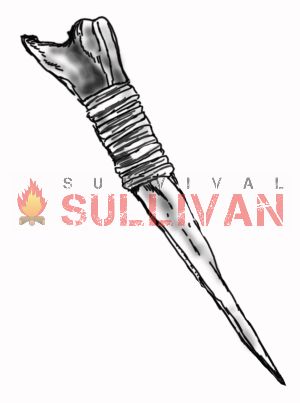
Primitive Knives
Once man started using tools and weapons it didn’t take long for him to develop a handheld weapon designed for stabbing and slicing, the knife. The origins of the knife began by wrapping one end of a pointed bone or antler with leather to create a slip-resistant grip handle.
Rubbed on a rock until nearly needle shard, this earliest weapon didn’t cut but it could stab. Used for close-quarters combat when your opponent is right up on you, stabbing created holes to let blood in order to bring down your opponent. See a bone knife made here:
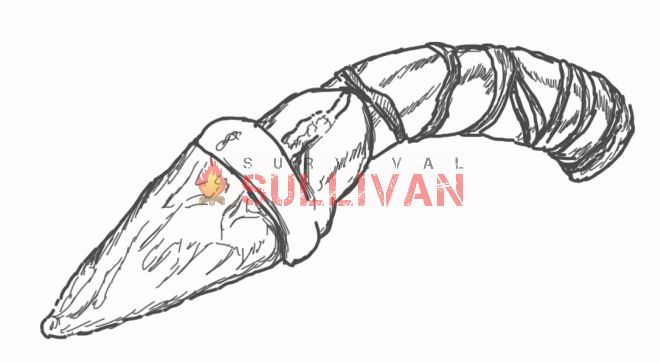
When man discovered he could chip flint (this is called flint knapping) and create very sharp edges he began to create knives and other cutting tools such as skinning tools from this sharpened flint stone to skin and butcher animals.
Again, with the advent of metallurgy, he began to make knives and then swords from copper, bronze, iron, and finally steel.
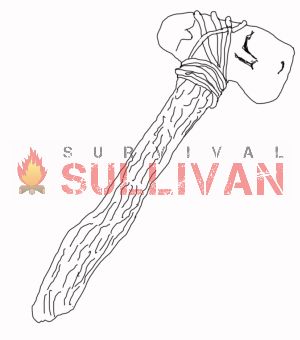
Another weapon used for up close and personal combat came about in the form of the axe.
The first axes were simple hand axes made from stone and used to crack bones to access the marrow and to cut wood to build fires.
Eventually, man realized by adding a handle he could get more leverage and make the axe more effective.
As with the other weapons, axes went from being made from stone to being made from copper, bronze, iron, and then steel.
Here is a video showing how to create a stone axe, (this guy really knows his stuff):
Axes, knives, and swords were also used prolifically in war in ancient times, and are still used widely today all over the world. Although firearms are used in modern warfare, modern military rifles are still designed so that they can be fitted with a bayonet.
A bayonet is a long, sharp blade that is designed to be fixed to the muzzle end of the rifle for use in close quarter hand-to-hand combat.
These bladed weapons can be made to be just a simple basic tool or a beautiful work of art adorned with the precious metals gold and silver, and inlaid with gemstones.
Bows and Arrows
The epitome of primitive weapons without a doubt has to be the bow and arrow. Still widely in use today in competition sports and hunting, (there are archery competitions in the Olympics) evidence of the bow and arrow spans back an estimated 70,000 years based on finds of ancient artwork from the southern coast of Africa.
Bows
The bow can be made two ways, one way it is made from a single piece of wood cut from the edge of a branch so that hardwood and sap wood existed along the shaft, this gave the bow shaft flexibility.
Another way, which makes a stronger bow, is made with elastic material, usually sapwood from certain trees, for the opposing limbs and a solid material such as hardwood for the riser (the center grip).
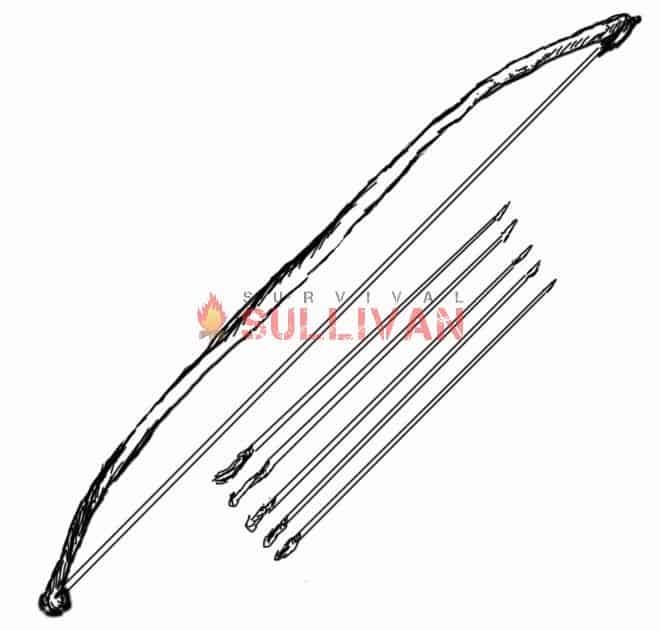
This was achieved in ancient times by using different types of wood laminated together using animal glue, (animal glue is made by boiling connective tissue, ligament, or tendon) and wrapping the joints with sinew, (sinew is a tough, fibrous material also made from connective tissue, ligament or tendon) or leather for added strength and durability.
Leather strips would be applied wet and, when they dried, they would shrink and draw up very tightly.
The bow is strung from end to end with a cord (called a bowstring), also made from sinew or plant fibers such as hemp or flax and often waxed with beeswax or treated with animal fat to help waterproof and preserve it.
The bowstring was tied to the ends of the limbs into notches called nocks. The nocks were often strengthened by laminating bone over the wood to prevent the bowstring from wearing into the wood.
The riser of the bow usually had a notch cut into the side in order to provide a small ledge for the arrow to rest on. Aiming is done by bringing the arrow up as close to the eye as possible and looking down the shaft of the arrow to the target.
It takes some considerable practice to become proficient at estimating distances and learning the trajectory of the arrow in order to accurately hit your target.
Here is an excellent video of a one-piece bow being made and used:
Arrows
The arrows are made from thin straight branches, saplings, reeds, or bamboo, depending on the materials available in the area where they are being made.
An arrow straightener was often used to straighten the shaft. The end of the arrow towards the bowstring is cut with a notch called a nock, (just like the nock on the limbs) to fit around the bowstring.
Fletching, used to stabilize flight, is affixed to this end as well. It was usually made by splitting large feathers and sticking them on with pitch or sap and wrapping them with a fine string made from plant fiber or sinew. Modern arrows typically have three.
The business end of the arrow was fitted with a knapped stone originally, progressing through the stages of metallurgy with copper, bronze, iron, and then steel heads. The arrowheads are shaped in various ways depending on their intended purpose.
Hunting tips, known as broad heads, had a broad, triangular shape to cut a large bloodletting wound. Tips for fishing are long, thin, barbed tips, or multi-pronged.
Arrowheads designed to pierce armor in wartime were usually sharply pointed caps or small broad heads with sharp edges designed to puncture steel armor.
Modern versions of these include spring-loaded tips for fishing that pop out to make it impossible for the fish to come off and broad head hunting tips have evolved to three or four razor-sharp blades with a sharp, hardened steel point.
Blowguns
Another projectile weapon that can be used to take small game is a blow gun. In ancient times these were made from hollow reeds or bamboo.
Today you can make one from any kind of tubing lying around, copper or PVC pipe is readily available in areas of civilization, but in the woods, you have to find some natural tubing.
You can even make one from duct tape:
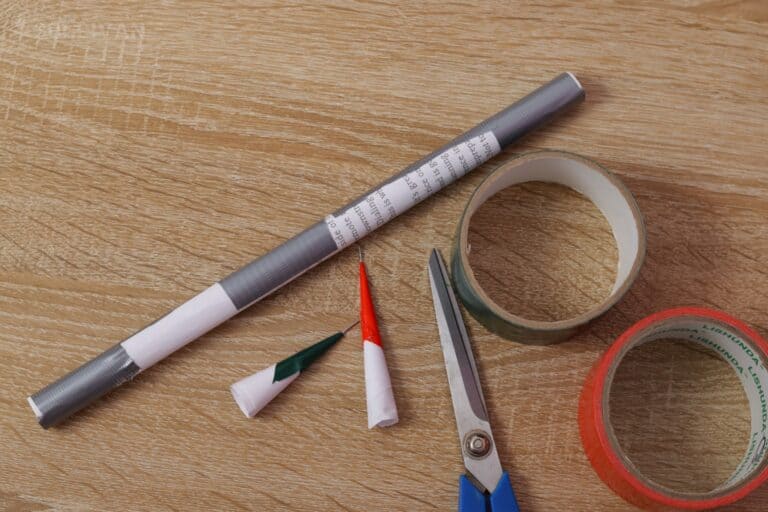
Darts are made from cactus needles or carved wood and fletched with feathers or plant material. Loading the dart in the rear of the tube and then blowing a sharp puff of air will send the dart flying.
Natives of certain South American tribes would poison the tips of their darts in order to take large game. When several tribe members blew darts into an animal at once it would run, only to spread the poison through its system faster and bringing it down.
These people are very skilled and knowledgeable about the use of plants and animals to make poisons that, although would kill their prey left no harmful remnants that could hurt them. So it’s best to leave the poison to them.
Here’s a video of the real deal being made:
Primitive Clubs
All of the above-mentioned weapons require some level of skill to create. We have to keep in mind that some people just do not have the ability to create handmade objects.
For those people, it might be best if they just rely on a simple, yet effective, weapon. A club; a club is likely as old a weapon as the rock.
It’s pretty simple, find a stick two to three feet in length with one end suitable for holding and widening to a hefty, weighted end. It doesn’t get any easier than that.
Of course, you have to get really close to use it for hunting, but in a self-defense situation, it’s expected that an assailant will be trying to get close to you to do you harm. So a hefty stick to the head should do the trick.
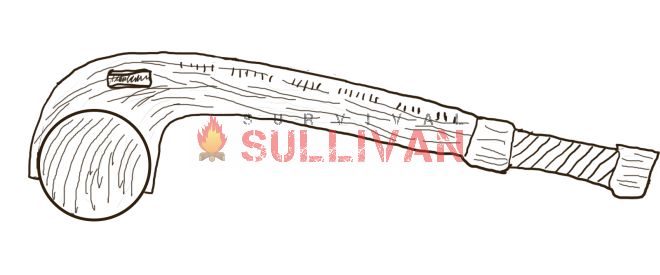
Clubs were actually used by many Native American tribes prior to and alongside the tomahawk that we commonly see depicted in books or in movies.
Here is a great example of how to make an authentic Indian war club, although you’ll have to use a sharp rock instead of an angle grinder:
Sap
A sap is a special type of impact weapon, usually in the form of a short club or baton. But unlike a typical club, a sap is a flexible one: atop the shaft is a pouch, bag or other enclosure containing fine, weighted media. For a primitive sap this will usually be a leather or woven pouch holding sand, fine gravel and things like that.
The nature of the sap greatly increases impact out of all proportion with its small size, and among all the primitive weapons you might craft and carry this is one that can pack the biggest wallop in the smallest package.
The tricky part about constructing a sap is making a strong enough pouch, but this is entirely possible if you have access to sturdy leather or can weave a bag or tight mesh net out of strong cordage. This is a tremendous weapon for self-defense, and also excellent for dispatching wounded or captured animals.
Warhammer
If you have need of a versatile striking weapon, you might try crafting a warhammer. Chances are when you hear the word you’re probably thinking of either a comically oversized mallet or else an actual warhammer complete with a pronged strike face and a hooked beak on the back side.
Our primitive version will be very similar to the latter, but we’ll have nothing in common with the former. That’s because it isn’t a tool for driving tent pegs.
A primitive warhammer usually consists of a handle and a stout head made from wood, bone, antler or stone. The strike face will be flat, but small and overall width and surface area to increase damage. It might even have a slight protrusion to further amplify impact.
But whatever material it is made of, the back side will be a sharply tapered cone, or even a genuine spike in the case of an antler or if you are using a large, broken leg bone from a large animal. This allows one to quickly reverse the warhammer in hand and deliver a ferociously penetrating strike when called on.
This, as you might imagine, is useful in all sorts of combat situations, and it might even retain some use as a utility tool. The hard part is it simply making this weapon sturdy enough to stand up to repeated, full-power blows. You want to use the best cordage you have, leather wrapping and any natural adhesive you can fashion in the form of a pitch or tar.
Boomerang / Throwing Club
The boomerang is nothing more than a throwing club, but one specially designed to fly true and deliver tremendous force upon impact. They do not return to the user’s hand when thrown as a rule, and that is a feature of more modern-day boomerangs.
A useful throwing club will usually be designed somewhat differently from one designed to be kept in the hand in use, and often feature a crook or bend in the neck with a pronounced protuberance on one side.
Though these weapons have a sweet spot range for delivering maximum impact, careful design ensures that a strike from this sweet spot is highly likely.
Most effectively made from a single piece of strong hardwood, some throwing clubs do rely on multipart construction.
One popular example used the world overtakes the shape of a cross or four-pointed star, being little more than a pair of sturdy branches that are notched out and lashed together in the middle.
When thrown overhand and with force it is virtually assured that at least one of the ends will strike the target. These weapons make for a good first-strike option against human foes and also work well against small and medium game animals.
Traps
Traps, like everything else on this list, are ancient weapon systems that remain just as viable today and can allow a creative person to bag game animals while hunting or protect their territory in new and unexpected ways.
Traps may be victim actuated, meaning the animal or person interacts with a trigger that sets the trap in motion, or command activated, meaning you interact with the trigger to activate the trap. Both can work and both are viable, but which one is best depends on the type of trap you are using.
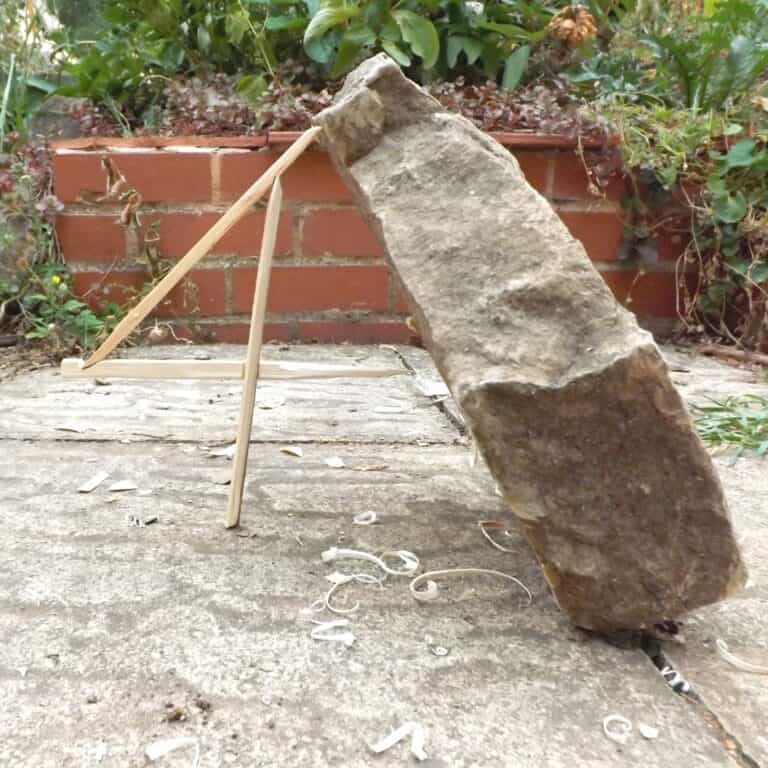
Traps can be as simple as a camouflaged pit or as intricate as a whip spike or deadfall complete with a concealed log studded with sharpened stakes.
A full discourse on the sheer variety of traps that are out there, the best way to construct them, and the best way to employ them is far beyond the confines of this article, but if you like the idea that autonomous traps could take the place of an entire hunting party or group of warriors, I suggest you look into them.
Bola
The bola, or bolas, is a throwing weapon that hails from Central and South America, and is designed to entangle or snare from a distance or alternately to injure or kill depending on the design.
Consisting of little more than two, three or sometimes more weights connected by various lengths of cord, a bola relies on centripetal force to increase the distance that it can be thrown accurately and also increase the likelihood that it will entangle the legs of the target when it strikes.
This is an extremely simple weapon and most preppers can easily make a bola that is reasonably effective using nothing more than scavenged stones and some cordage that they happen to have handy, but lacking even that, handmade rope or vines can also be used.
In operation, the bola is often used in tandem with a close-quarters weapon, be it a spear, club, or something else.
The bola is thrown and either hinders the prey (or the victim) and prevents them from fighting back effectively or running away at full speed, or else it completely ensnares them and brings them down. So ensnared, whatever has been unfortunate enough to be caught by the bola is easily dispatched by other weapons.
Antler
Antlers, taken from any animal that grows them, or a shockingly effective weapon when used as design, and just as effective when removed and wielded by humans.
The antlers of many species, but particularly deer and elk, are hard, sharp, and durable and make for highly effective stabbing weapons or additions to other weapons in order to increase effectiveness.
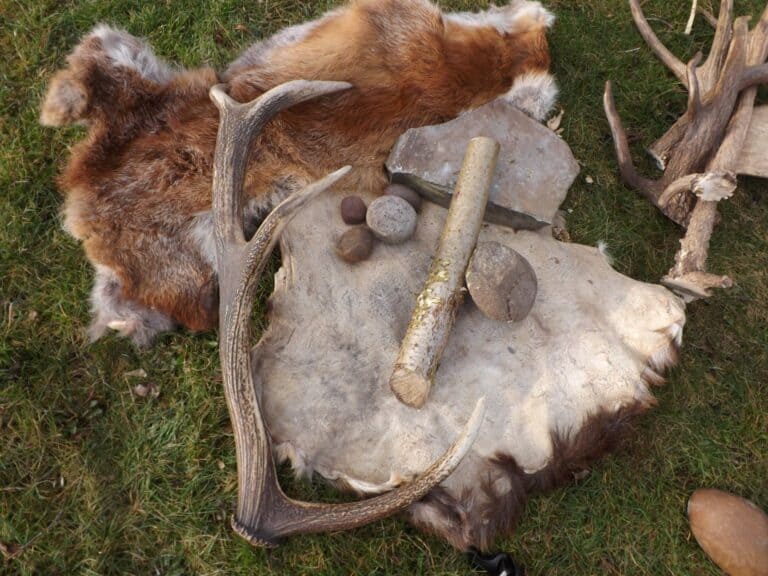
Antlers can also be sharpened easily to further increase their killing potential. Antlers taken from near the base of the rack where they grow from the animal’s skull are particularly strong and serve as an excellent handle for a stabbing dagger that works akin to a stiletto.
Smaller tines can be removed and sharpened, added to clubs, or used as components in the trap mentioned above.
You will rarely find natural materials that serve as purpose-made weapons and are so suitable to be used as much with virtually no modification. If you live in an area where antlered animals are common, you should make all attempts to find shed antlers or harvest them from animals that you kill.
Mace
The mace might be thought of as an improved club, or an upgrade to club technology. Another weapon that relies on blunt force trauma to do damage, a mace consists of a weighted head attached to the top of a handle, long or short.
When swung, this head will be moving at considerable velocity and in conjunction with its mass and perhaps some strategically designed protuberances to focus the impact forces; maces can do incredible damage even though they are a very low-tech weapon.
Maces have been around for a very long time, and the earliest of early examples consisted of little more than a round or oblong stone attached to the top of a sturdy shaft of wood. The Neanderthal vibe is strong, but that doesn’t mean it isn’t incredibly effective!
Maces can be further improved by shaping the stone or any other material weighty enough for inclusion into prongs, domes or points that will focus the impact on a small area and further magnify damage.
The mace is particularly effective against hard targets with little protection from flab or muscle, so striking for the head, rib cage or the major joints where limbs connect to the torso or hips is a sure strategy for success.
Flail
The flail is a cousin to the mace, but one that is even more destructive. It consists of the same, or similar, heavy striking head but this time it is connected to the handle by means of a length of strong cordage. Ancient battlefield flails or usually connected by a series of hinged links or chain, but you can buy all means use if you have access to it.
The single biggest advantage of a flail over a typical mace is that the striking power is even greater thanks to the physics at play. During battle with humans, it can also strike around a block or parry and still do damage. That’s quite the asset!
The disadvantage to a flail, though, is that if you miss it will leave you wide open, to say nothing of the chance that the head might continue on its travel and return to sender, striking you! This is one weapon where you must commit to every blow, but when you land one it will really land!
Push Dagger
A push dagger is a little more than a T-shaped stabbing weapon, consisting of a handle that is gripped in the hand akin to a roll of quarters or the handle of a baseball bat with a thin spike or blade protruding between the ring and middle finger or between the index and middle finger.
And use, the user punches normally and adds substantial kinetic energy to a stabbing implement.
Very easy to make from natural materials like branches and antlers or cobble together from both natural and man-made materials, push daggers are limited only by their short range.
These are true point blank weapons, but can make for an excellent form of defense when tangled up with another human or a large and dangerous animal.
The best attribute of the push dagger is the fact that it relies on no additional skill sets except raw instinct or whatever skill at throwing a punch has already been developed. If you know how to throw a good punch, be it from the clinch or not, it will be geometrically more effective when you do it with a push dagger!
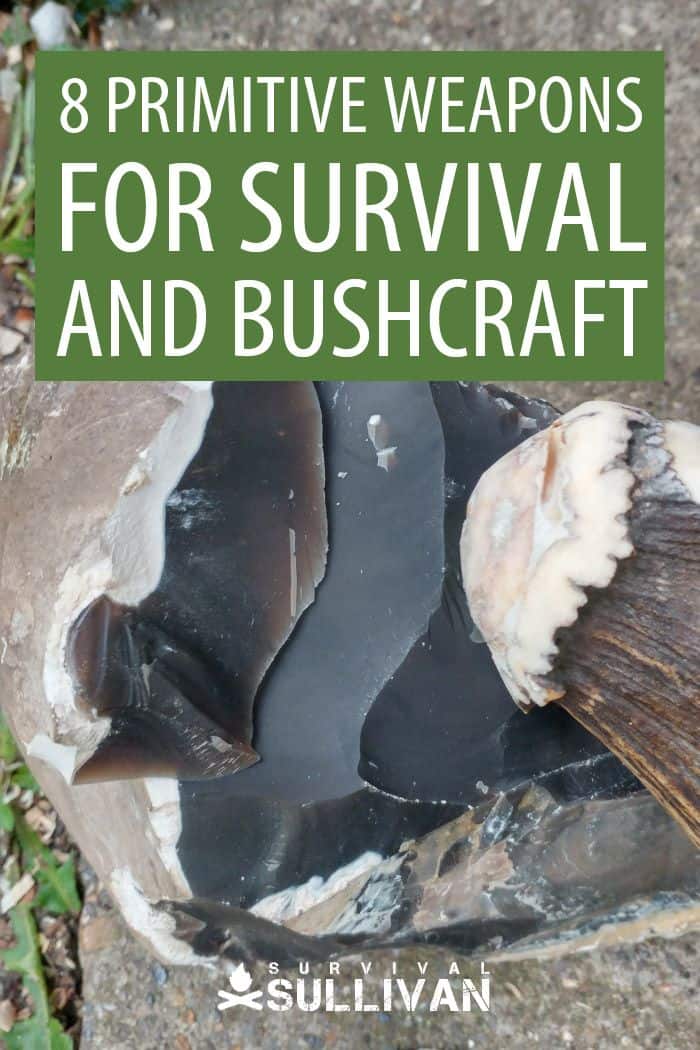
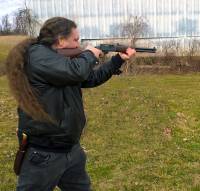
Eric Eichenberger is an avid outdoorsman, skilled marksman, and former certified range officer and instructor with nearly 40 years experience handling and repairing firearms.
A skilled craftsman with a strong love for working with his hands, Eric spent 20 years as a carpenter and custom woodworker in high end homes. As a gold and silversmith he has created hundreds of pieces of jewelry over the years using the lost wax casting method.
The grandson of humble country folk, he was raised with the “do it yourself” mentality and so is accustomed to coming up with unique solutions to problems utilizing materials at hand.
